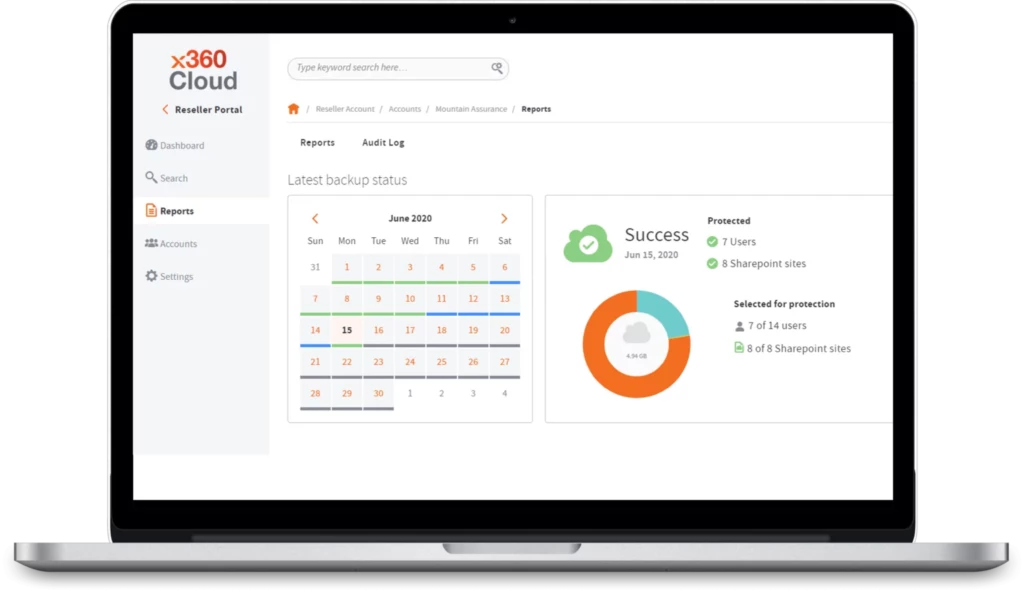Axcient x360Cloud for Microsoft 365 and Google Workspace
Backup. Search. Restore. Audit.
Protect business productivity applications with x360Cloud for Microsoft 365 and Google Workspace
Data loss happens, even in the cloud. But can your clients afford to lose important emails, contacts, calendars, and work documents?
Microsoft 365 is the go-to productivity suite for businesses. Unfortunately, user errors including accidental deletion, malware infections, and bad actors such as hackers or malicious employees pose serious risks to your clients’ productivity. x360Cloud for Microsoft 365 and Google Workspace ensures that the data used in an organization’s instance is backed up, protected, restorable, and compliant.

Critical capabilities of x360Cloud includes:
Unlimited storage and retention for Microsoft or Google data
Google Workspace and shared drive backup
Quick and easy to setup – start backing up in less than 10-minutes.
SmartSearch for fast full-text search across users and services for a single-click restore.
Backup of Exchange Online, OneDrive, SharePoint, and Teams data
AirGap to protect your backups against accidental deletion, or attackers and ransomware.
HIPAA, SOC-2, and GDPR compliance
Rich filtering to restore or export to a folder to satisfy e-discovery requests or export immutable audit logs and granular backup reports to support third party auditing.
Ready to try x360Cloud?
Start a free 14-day trial
Cloud vs. Appliance-Based BDR
Guide:
When to Deploy What?
Deployment considerations when deciding whether to use hardware-free cloud backup versus appliance-based backup.
Axcient’s business continuity and disaster recovery (BCDR) solutions provide MSPs and their clients choice and flexibility.
Our all-in-one x360Recover solution allows MSPs to meet all client needs with just one vendor – endpoint backup, no-appliance BDR, turn-key BDR, and public or private cloud backup. But, with all of these deployment options under one roof, how do you choose the best infrastructure for each client?
MSPs must consider:
- When to use Direct-to-Cloud hardware-free backup versus appliance-based backup.
- What deployment considerations need to be taken into account.
- How built-in features explicitly designed for MSPs enhance either deployment option.


x360 Recover Direct-to-Cloud
Direct-to-Cloud: Business Continuity Without the Local Appliance
Direct-to-Cloud is best…
- For clients who don’t want a dedicated turn-key
appliance because of cost or distributed IT. - When protecting virtual machines (VMs) in the cloud, or in other cases when local backups are not desired, use D2C for Microso Azure to separate backups from the production infrastructure to avoid complete downtime.
- When protected machines roam to di erent networks – for example when endpoints are not on the same local area network (LAN).
- For protecting servers when used with Local Cache – an optional, fully independent D2C feature that pairs D2C with an inexpensive local USB or NAS device to substantially decrease recovery and failback times.
- If cloud-based recovery is suitable for protecting
servers without Local Cache, or if it is acceptable for restore speeds to be limited by Internet speed. - For protecting desktops or laptops, with or without
Local Cache. - When you want to leverage existing devices – including network-attached storage (NAS) devices, USB disks, and Windows-based BDR devices.
Consider these deployment components:
- D2C doesn’t take local backups separate from cloud backups. An Internet connection is required for backups,
and the backup speed is dependent on the Internet connection speed. - The initial backup could take days or weeks, depending on bandwidth. D2C can run concurrently with the
existing backup vendor or Windows backup until the initial backup is complete. - Fast local recovery from the local cache requires an Internet connection to download the encryption key and recovery point indexes. More than 99.9% of data will come from Local Cache.
- Instant local virtualizations require a local Hyper-V
desktop or server to access Local Cache. - If the client has no hardware for local virtualization, we recommend keeping a spare ‘recovery BDR’ in your MSP office with Hyper-V preloaded that you can transport to a client needing recovery.

x360 Recover
Traditional Appliance-Based BCDR
Appliance-Based BCDR is best…
- When you need dedicated hardware on-site for instant local failover of backed-up workloads.
- When you need to continue local backups even when the client’s internet connection is down.
- When you need to do local restores even when the client’s internet connection is down.
- When you need to separate time of backups from time of replicating data to the cloud.
- When a client has low bandwidth, or you need to do a physical seeding of cloud backups.
- For protecting physical or virtual servers that need dedicated on-site infrastructure for failover.
- For protecting desktops in an office where an appliance is already deployed to protect servers.
Consider these deployment components:
- Appliance-based BCDR requires an appliance at each client site. Use a turn-key Axcient appliance (USA only), other compatible x86 hardware, or a Hyper-v/VMware VM that can be deployed via a bootable installer ISO.
- Existing x86 hardware (servers or desktops and some competitive BDR units) can be replaced to be an x360Recover appliance or vault. Check the hardware compatibility list for supported hardware configurations and solutions.
- Local recovery has no dependence on the Internet. Zero data is downloaded for local recovery.
- Local recovery is performed via the appliance’s web-based graphical user interface (GUI) – which can be accessed via the x360 cloud portal, or locally via a web browser – or can also be performed via the Windows Recovery Center application.
- Physical seeding of the initial backup is possible, but not required. Incremental backups are replicated to the cloud even while a physical seed drive is in transit.
Built-In BCDR Features Make Both Deployment Options Beneficial for MSPs
Chain-Free backup technology
eliminates the need for periodic or manual reseeding to reduce overhead dramatically.
Chain-Free backup technology
eliminates the need for periodic or manual reseeding to reduce overhead dramatically.